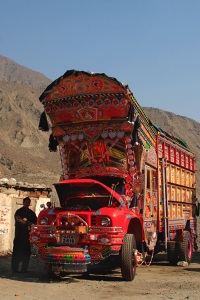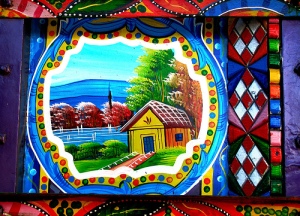Source: http://wondersofpakistan.wordpress.com/2008/07/30/huge-brides-on-the-move-2/
Truck art, as any one knows, is one of the great folk arts of Pakistan. These heavy machines affectionately called “brides” by truckers are covered mostly in vivid bright multilayered colors and fairy lights which have a talismanic function of warding off evil spirits and promote good luck – something one needs in plenty when navigating our roads. But apart from this magical effect, truckers have another romance with these brightly colored vehicles.
Salamat a typical truckwala admits that he spends more on decorating his truck than he paid for his second marriage a couple of years ago. “I spend most of my time in my truck. It’s like a second home to me” says Salamat.
WOP contributing editor
and an award winning photographer Umair Ghani went an extra mile at each stop; which he did at the most stopovers (the dining cum resting places on road sides) to have a face to face and heart to heart chat sessions with this trucking community of Pakistan.
“GT Road te duhaiyan pawe, nin yaaran da truck baliyay“
[Look my love, how magnificient does your lover roam on the GT Road]
Standing along a tea stall on the Grand Truck Road near Jehlum, I listen to the upbeat Punjabi Bhangra as trucks in many colors, decos and carvings whirlpass me. In a flash, I conjecture on the assignment I have and just muse on the art of painting especially the art of painting trucks in Pakistan, an art unique to our country. None of our geographical neighbours, neither the Indians in the east nor the Afghanis in neighbouring north indulge in this special art.
My fascination with painted trucks of Pakistan starts from Jamal J Elias of the University of Pennsylvania. I read his article and have an email from him that inspires me to get on road and capture the exquisite beauty of design and color of Bedford trucks moving on the roads of Pakistan.
You see them everywhere,”
Elias wrote in his article, “But a lot of people don’t see them. One day I started staring at them, very carefully. And I started to see there was some order to the madness.”
Elias took six years to compile the monumental work for his forthcoming book “On Wings of Diesel”, and it is still in continuation. I traveled some 5000 km in three months, from Karachi to Khunjrab Pass traversing through deserts, plains, passes and awe inspiring mountains along the KKH. I met many interesting people, roadside artists (Street Picassos I call them) unforgettable experiences in my quest for the unique vehicle art in Pakistan. During all those wonderful episodes of exploration, I had but one consistent inspiration from that genie of Pakistani truck art — Jamal J Elias.
Sipping morning tea from a tiny china clay cup in a roadside truck drivers’ tavern on the banks of river Indus, I looked at the long stretch of Karakoram Highway winding high into the far distance. It was only a night before when I reached Bisham from Lahore. I had been on road for many days without rest pursuing truck caravans bound for Sost [last Pakistani outpost on Pak-China border]. Morning sun shone brightly over the mud roof of driver’s hotel a few kilometers ahead of Bisham. We sat on huge charpoys, sipped more tea as Sada Khan talked about his magnificent red Bedford parked outside. “This truck is my bride. That’s why it is painted red. I have spent most part of my life with it than at my home with parents and the family. Like a newly wed bride, it should look beautiful, enticing and alluring.” relates Sada Khan with the magic touch of an apt story teller of the Asian world. Soon, the tantalizing channa dal and parathas arrive and breakfast begins in a formal manner. Sada Khan relaxes himself on the multi colored blankets piled on the charpoys and continued his tale.

[Right: Me and My Bride]
“I fell in love with truck decorations in Peshawar, where I was a helper boy at truck stations decades ago. I know that an aesthetically decorated truck can make you jealous, envious at best and you cherish the dream to outclass others by more eloquent designs and patterns.”
A normal sized Bedford truck takes three to four hundred thousand rupees to be painted and decorated in style, a sum that amounts to two years’ salary of an average truck driver. Yet, many of them spend whatever fortunes they have on truck paintings. It may take one to two months for the truck to get ready for the road. Truck workshops in Karachi, Ghotki, D.G. Khan, Peshawar, Taxila, Rawalpindi and Lahore are centers of decorative painting (the beauty salons) of these moving “brides”. To some extent truck painting is done in Afghanistan, India, Indonesia, Malaysia and Philippines as well but not so explicitly as they do this here in Pakistan.

[Left: A Blend of Bright, Multilayered Colors]
Here it is an elegant blend of styles, color and designs which is easily distinguishable from their contemporaries elsewhere. The themes of Pakistani truck art are mostly religious, patriotic and cultural. The fascinating diversity of images from secular to religious and sometimes of many individuals, thoughts and views idealise by the artists also come on the moving frames. It includes also famous actresses and cricketers who frequently appear on wooden planks. Winds of cultural change though have replaced leaders, martyrs and other celebrities of the yesteryears with missiles and new age heroes like country’s nuclear scientist Dr A. Q. Khan, after the country stepped into the prestigious Nuclear Club in 1998.
“Patriotic Billboards” as many Westerners label these vehicles, the trucks carry a huge number of religious signs and slogans as well. Images of holy Ka’aba and Madina appear mostly on the upper front (the Taj or crown of a truck) with names of Allah and the Holy Prophet. Verses from Holy Quran are either painted or hung in the form of plastic or metal pieces. Images of birds and animals most notably peacocks, pigeons, lions and tigers are drawn on the side panels. The ever present figure of Ayub Khan behind many trucks in NWFP and Balochistan has something to do with a mix of patriotism and nostalgia of the bygone days in a country which had then poor road infrastructure and almost non existent railroad system for mobilization on a mass scale. In that scenario, came forward Ayub Khan’s son as the country’s sole Bedford dealer (1962 – 1969) and made sure that Bedfords were the only trucks imported into the country.
Locally manufactured truckswere nowhere in the competition and when local artists created breathtaking masterpieces out of Bedfords they swept the market like a storm. J.M. Kenoyer, a renowned scholar of Pakistani culture comments, “The paint jobs identify competing ethnic groups. You look at a truck and can tell exactly what region it comes from and what ethnic group the driver belongs to.”

Through my multiple interactions with truck drivers, I came to know that truck painting for them was a labor of love, “and love makes you suffer”, whispered Badshah in a dingy tea stall in the outskirts of Multan. Truck drivers don’t spend much money on their families and houses. They view trucks as a deity which brings them income, joy and freedom of the road. “It’s kind of Bhagwan for us”, said Badshah displaying his tea and naswar smeared teeth and twirled his thick moustache with the thumb and first finger of the free hand. While listening to Badshah I recalled an article where Durriya Kazi, head of the department of visual studies at the University of Karachi and an encyclopedia on Pakistani truck-decoration, quoted such instances; “I remember one driver who told me that he put his life and livelihood into the truck. If he didn’t honor it with the proper paint job, he would feel he was being ungrateful to his machine.”
The sense of devotion and a bond of love keep the trucker and the truck chained together. For a truck driver, his vehicle is the life’s whole sphere around which circles his life, his love, likes and dislikes. He scarcely looks beyond that. “We don’t have to”, laughed Badshah, “and why should we when we feel protected and enormously proud in our beautiful paradise.” Charas (local brand of hashish), naswar (snuff) and tobacco are amongst some of the pleasures these truckers have in their rugged routines. The glorious art work provides an escape from the monotony of life. Music is another pre-requisite of this nomadic life on wheels. Truckers don’t dance nor even sing but are fond of folk tunes and songs that include regional flare. Atta Ullah Khan Eesakhailvi, Allah Ditta Loonay Wala and Zarsanga are among the most cherished singers. Multicolored laces hang from stereos and speakers covered in beads and plastic decorations which renders the truck’s interior pompously ornamental.
Booming truck painting industry despite all its magnitude and impact may not be a lucrative and lovable vocation for all. The people who work in it, the Sreet Picassos [truck painters] are mostly underpaid. Many ‘Ustads’ and their apprentices commonly called ‘chhotas’ create magnum opus out of a common Bedford for small amounts and scanty privileges. “Big chunks of the money goes to workshop owners”, said Hajji in a typical Lahori workshop famous for plastic and metal work. “This art is a complete exhibition on wheels which involves arduous labor and a careful placement of each piece of colored plastic, every stroke of paint brush and carving and engraving on the panels and sides”, he explains amid chugging of heavy engines and noisy rattle of metal plates. Though well known and respected for their artistic skills, many of them are dissatisfied with marginal wages they earn from their creative art. They wish their kids to join school and get educated for better jobs.

Trucks began to draw attention in the transport industry in Pakistan when construction of major highways started in the country. This boosted transport of construction material business. To attract their customers, truckers started to get their vehicles painted and decorated for more business. More visibly decorated machines fetched better bargains. Stylised murals and bright red color did the job for many truckers. Some shrewd artists painted pictorial allusions that were alien to local culture and visual sensibilities to draw immediate attention. Some drivers [or designers] with a literary flavor, love to paint verses about dejection and betrayal of love. Some verses become slogans of drivers’ ideology and some of their very personal aspirations.
Goods and commercial companies jumped into the art competition and entire fleets of trucks came to workshops to be painted in designs exclusively created for each corporate competitor. A nation of 140 million people needed loads of supplies to be hauled from one part of Pakistan to another, So Bedford, Hino, Volvo, Isuzu and Mercedes ‘ heavy machines traveled in form of chained caravans. Now truck painting is recognized as a form of cultural diversity. Decorated brides of truck drivers move in splendor all across the country with unprecedented pomp and show.
Photographs: Umair Ghani, Mujahid-ur-Rehman, Lahore, Pakistan Plates: Shahidul Islam / DRIC Gallery, Dacca, Bangladesh





What a great idea for a blog - I ABSOLUTELY love the trucks there ! They're such a work of art . Would love to see more posts !
ReplyDeleteShivani